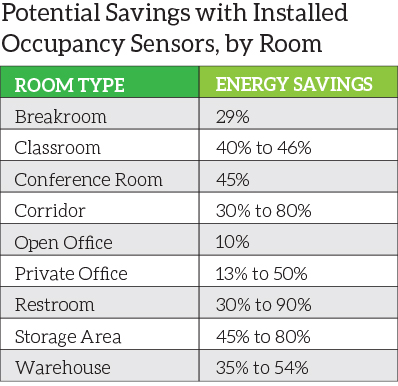The LightCorp customer service team often fields questions about vacancy and occupancy sensors– such as what they do, what’s the difference between them, and why they are useful. This blog post aims to provide you with some useful background knowledge about this highly-sought-after lighting feature.
What are occupancy and vacancy sensors?
To begin, occupancy and vacancy sensors are defined as a mechanism that senses the presence of an occupant in a space to control lighting for the purpose of energy conservation. Also referred to as motion sensors, (or sometimes presence sensors) these lighting controls can power a fixture on and/or off, or can even dim the brightness of a fixture, depending on its programming.
What’s the difference between an occupancy sensor vs. vacancy sensor?
An occupancy sensor will automatically power a fixture off after a period of no movement detection, and then automatically power back on immediately as a person re-enters the detection range (auto-off/auto on).

Vacancy sensors will also automatically power a fixture off after sensing no movement but will require the fixture to be manually turned on to operate again (auto-off/manual on).
Automatic turn-off is another type of lighting control but is not considered an occupancy sensor. If a lighting fixture includes the automatic turn-off feature (many of ours do), it will rely on the programming within the circuitry to stay illuminated for a pre-determined amount of time before shutting off automatically.
Although occupancy sensors and vacancy sensors operate differently, they are both collectively referred to as occupancy sensors and will share this common reference for the remainder of this article.
How occupancy sensors work
Most occupancy sensors operate by either infrared (heat), ultrasonic (sound), or microwave technology. LightCorp products that have this feature use passive infrared (PIR) technology in their sensors. PIR sensors measure infrared radiation by the shifting heat patterns within an area, making these motion detectors ideally suited for use in defined areas, such as private offices or workstations.
The benefits of sensor-controlled lighting
Aside from considering convenience, where occupancy sensors truly shine (pardon the pun) is when you consider the potential energy savings they can afford. According to the U.S. Department of Energy’s 2011 Buildings Energy Data Book, lighting accounts for 20% of the energy consumed in a commercial building. By employing an automatic safeguard that keeps unnecessary lights off in intermittently used areas like conference rooms and touchdown spaces, the savings can be substantial. The table below created by the DOE shows the approximate savings potential by types of rooms commonly found in commercial buildings.

Designing occupancy sensors into the overall lighting plan is becoming more than just a sustainable best practice in commercial construction and remodeling projects- it’s becoming mandatory. Energy-conserving lighting controls are now required by energy codes as well as green building standards such as the U.S. Green Building Council’s LEED Certification.
LightCorp task lights Revo, Voyage and Tino, as well as under shelf light, Reed Premier, include an occupancy sensor option within their feature set. To learn more about these, or how to best integrate occupancy sensors into your lighting plan, contact our Customer Care Team at (800) 544-4899.

